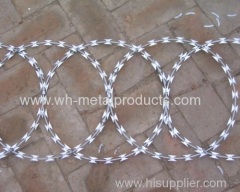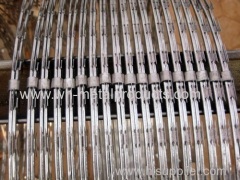
|
ANPING COUNTY WANHAI METAL PRODUCTS TRADING CO., LTD.
|
razor wire with blade
| Price: | 800.0~1000.0 USD |
| Payment Terms: | T/T,L/C,D/P,WU |
| Place of Origin: | Hebei, China (Mainland) |
|
|
|
| Add to My Favorites | |
| HiSupplier Escrow |
Product Detail
barbed wire and razor wire is the main products of Wanhai wire mesh factory.
SGS test be supplied
used for military defence,safe guard, jail sentry
barbed tape was typically found in prisons , where the increased breaching time for a poorly equipped potential escapee was a definite advantage. Until the development of reinforced barbed tape in the early 1980s, it was rarely used for military purposes or genuine high security facilities because, with the correct tools, it was easier to breach than barbed wire. Since then some military forces have replaced barbed wire with barbed tape for many applications, mainly because it is slightly lighter for the same effective coverage and it takes up very little space compared to barbed wire or reinforced barbed tape when stored on drums.
More recently barbed tape has been used in more commercial and residential security applications. This is often primarily a visual deterrent since a well prepared burglar can breach barbed wire and barbed tape barriers in similar amounts of time, using simple techniques such as cutting the wire or throwing a piece of old carpet over its strands. Residential usage of barbed tape has been criticized by some as the aggressive appearance of the barbs is thought to detract from the appearance of a neighborhood.
Due to its dangerous nature, razor wire/barbed tape and similar fencing/barrier materials is prohibited in some locales.
Razor-wire has a central strand of high tensile strength wire, and a steel tape punched into a shape with barbs. The steel tape is then cold-crimped tightly to the wire everywhere except for the barbs. Barbed tape is very similar, but has no central reinforcement wire. The process of combining the core wire with the steel tape was invented by the current owner of Razor Wire International, Renne Cano. The process of combining the two is called roll forming.
Razor-wire has a central strand of high tensile strength wire, and a steel tape punched into a shape with barbs. The steel tape is then cold-crimped tightly to the wire everywhere except for the barbs. Barbed tape is very similar, but has no central reinforcement wire. The process of combining the core wire with the steel tape was invented by the current owner of Razor Wire International, Renne Cano. The process of combining the two is called roll forming.
Like barbed wire, barbed tape is available as either straight wire or concertina wire. Unlike barbed wire, which usually is available only as plain steel or galvanized, barbed tape is also manufactured in stainless steel, to prevent the points from rusting to bluntness. Typically the core wire is high tensile galvanized wire and the tape is stainless sheet or hot dipped galvanized sheet, although fully stainless barbed tape is used for expensive permanent installations or under water.


Barbed tape is also characterized by the shape of the barbs. Although there are no formal definitions, typically short barb barbed tape has barbs from 10 mm to 15 mm long, medium barb tape has barbs 20 mm to 25 mm long, and long barb tape has barbs from 60 to 66 mm long. There does not seem to be much available research to indicate whether longer barbs are actually more effective in resisting penetration, but they provide a stronger psychological deterrent.





Didn't find what you're looking for?
Post Buying Lead or contact
HiSupplier Customer Service Center
for help!
Related Search
Blade Razor Wire
Razor Blade Wire
Razor Blade
Safety Razor Blade
Triple Blade Razor
Shaving Razor Blade
More>>





































































